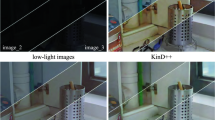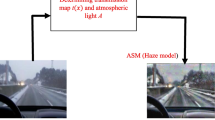Abstract
Inclement weather existence of fog, haze, and dust generally degrades the visibility of outdoor images. Bad visibility may cause failure in computer vision applications. Existing dehazing methods cannot work well on dust haze images. Such images appear yellowish due to the absorption of blue light by dust particles. In order to solve this problem, we propose an optical compensation method (OCM), which uses histogram matching to change the RGB color channel. In this method, take the red channel as a reference curve and then fit the color curves of the blue and green channels close to the red curve, thereby dust haze images are transformed into haze images. Furthermore, we develop a novel single image dehazing method based on Gaussian adaptive transmission (GAT). GAT uses a Gaussian function with a linear coefficient constraint to optimize the transmission, which can prevent halo artifacts near edges of depth discontinuity and obtaining a more accurate estimate of the transmission, especially in bright areas (e.g., sky). The experimental results show that OCM can eliminate the color cast of dust haze images, and GAT can enhance the visibility of dust haze images effectively.














Similar content being viewed by others
References
Cai, B., Xu, X., & Jia, K. (2016). An end-to-end system for single image haze removal. IEEE Transactions on Image Processing,25(11), 5187–5198.
Cooper, T. J., & Baqai, F. A. (2004). Analysis and extensions of the Frankle-McCann Retinex algorithm. Journal of Electronic Imaging,13(1), 85–92.
Dippel, S., Stahl, M., & Wiemker, R. (2002). Multiscale contrast enhancement for radiographies: Laplacian pyramid versus fast wavelet transform. IEEE Transactions on Medical Imaging,21(4), 343–353.
Gonzalez, R. C., & Woods, R. E. (2004). Digital image processing using MATLAB. Upper Saddle River, NJ: Prentice Hall.
Hautiere, N. (2008). Blind contrast enhancement assessment by gradient ratioing at visible edges. Image Analysis and Stereology Journal,27(2), 87–95.
He, K. M., Sun, J., & Tang, X. O. (2011). Single image haze removal using dark channel prior. IEEE Transactions on Pattern Analysis and Machine Intelligence,33(12), 2341–2353.
He, K. M., Sun, J., & Tang, X. O. (2013). Guided image filtering. IEEE Transactions on Pattern Analysis and Machine Intelligence,35(6), 1397–1409.
Huang, S. C., Chen, B. H., & Wang, W. J. (2014). Visibility restoration of single hazy images captured in real-world weather conditions. IEEE Transactions on Circuits and Systems for Video Technology,24(10), 1814–1824.
Kim, J. H., Jang, W. D., & Sim, J. Y. (2013). Optimized contrast enhancement for real-time image and video dehazing. Journal of Visual Communication and Image Representation,24(3), 410–425.
Levin, A., Lischinski, D., & Weiss, Y. (2006). A closed form solution to natural image matting. In IEEE computer society conference on computer vision and pattern recognition (pp. 61–68).
McCartney, E. J. (1976). Optics of the atmosphere: scattering by molecules and particles (p. 421–421). New York: Wiley.
Meng, G. F., Wang, Y., & Duan, J. (2014). Efficient image dehazing with boundary constraint and contextual regularization. In IEEE international conference on computer vision (pp. 617–624).
Ren, W. Q., Liu, S., & Zhang, H. (2016). Single image dehazing via multi-scale convolutional neural networks. In Computer vision: ECCV 2016 (pp. 154–169).
Santra, S., Mondal, R., & Chanda, B. (2018). Learning a patch quality comparator for single image dehazing. IEEE Transactions on Image Processing,27(9), 4598–4607.
Song, Y., Li, J., & Wang, X. (2018). Single image dehazing using ranking convolutional neural network. IEEE Transactions on Multimedia,20(6), 1548–1560.
Sulami, M., Glatzer, I., & Fattal, R. (2014). Automatic recovery of the atmospheric light in hazy images. In IEEE international conference on computational photography (pp. 1–11).
Sun, W., Li, D. J., & Liu, H. J. (2013). Fast single image fog removal based on atmospheric scattering model. Optics and Precision Engineering,21(4), 1040–1046.
Tan, R. T. (2008). Visibility in bad weather from a single image. In Computer vision and pattern recognition, CVPR (pp. 1–8).
Wang, W. C., Yuan, X. H., & Wu, X. J. (2017). Fast image dehazing method based on linear transformation. IEEE Transactions on Multimedia,19(6), 1142–1155.
Woodell, G., Jobson, D. J., & Hines, G. (2006). Advanced image processing of aerial imagery. Proceedings of SPIE: The International Society for Optical Engineering,6246, 62460E.
Xu, H., Zhai, G., Wu, X., et al. (2014). Generalized equalization model for image enhancement. IEEE Transactions on Multimedia,16(1), 68–82.
Yu, T., Riaz, I., & Piao, J. (2015). Real-time single image dehazing using block-to-pixel interpolation and adaptive dark channel prior. IET Image Processing,9(9), 725–734.
Zhu, Q. S., Mai, J. M., & Shao, L. (2015). A fast single image haze removal algorithm using color attenuation prior. IEEE Transactions on Image Processing,24(11), 3522–3533.
Acknowledgements
This study has been supported by The National Natural Science Foundation of China (61561030).
Author information
Authors and Affiliations
Corresponding author
Additional information
Publisher's Note
Springer Nature remains neutral with regard to jurisdictional claims in published maps and institutional affiliations.
Rights and permissions
About this article
Cite this article
Yang, Y., Zhang, C., Liu, L. et al. Visibility restoration of single image captured in dust and haze weather conditions. Multidim Syst Sign Process 31, 619–633 (2020). https://doi.org/10.1007/s11045-019-00678-z
Received:
Revised:
Accepted:
Published:
Issue Date:
DOI: https://doi.org/10.1007/s11045-019-00678-z




